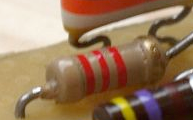Too bad, they were more than one inche long! And of course they did not fit.
I was so disappointed.
Now, I have decided that this should not happen to other beginners. Here is my guide to choose the correct resistors for building guitar effects.
Every component has a nearly infinite number of variations, and so does resistor, which is the most simple of them! You can find resistors of all shapes and colors on the market today...

It is easy to be lost with all this possibilities! No worries, it is quite easy to find what we need by considering all the different characteristics of a resistor:
- Its value (in ohms)
- How much power they can handle (W)
- Its composition
- SMD or classic component?
Acceptable power can allow us to eliminate a high number of candidates. Indeed, in our stompboxes, the power delivered by the power supply is really low.
Resistor resisting to 0.25W (the famous 1/4W resistor) will be enough. 1/8W can be used too in some cases. However, the classic resistor used in guitar pedal is 1/4W so I would recommand to stick with it, unless you need to save space. So we are already with our classical cylindrical resistor with two legs!
Next, we have to choose resistor type:
- Carbon comp resistor: dark brown resistor, they are also quite big. They were used in old vintage circuits from the 60s. They are useful if you want to replicate a vintage circuit with all its details. In other cases, they are not particulary good: they are big, quite noisy and expensive (because of "mojo").
- Carbon film resistor: light brown coloured, they usually have a 5% tolerance value. That means that their real value can be 5% different from the theoritical value. (it is not a lot) They also are quite cheap.
- Metal film resistor: the blue ones! They usually have a 1% tolerance. They also are cheap, and are the standard resistor that you are going to find almost everywhere. Moreover, they are less temperature sensitive, and noiseless!



It is then quite obvious that, unless if you want to reproduce perfectly a vintage circuit or to diminish costs (anyway, metal film resistors are super cheap too!), the 1/4W metal film resistors are the best choice to begin! Here is a good deal to have 1280 resistors of different values for a ridiculously small amount of money!

0 Comment